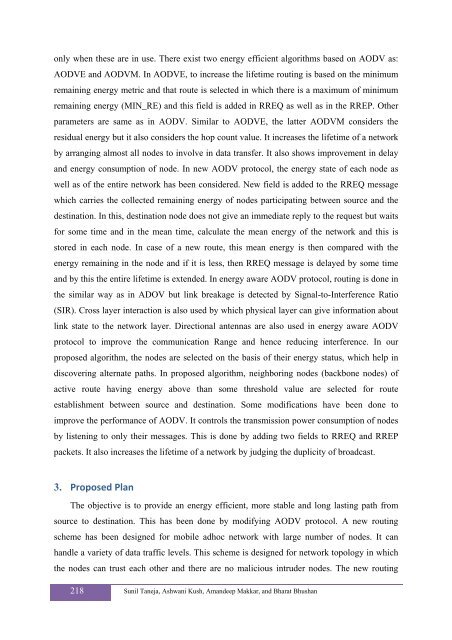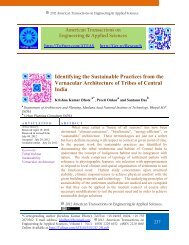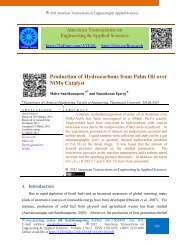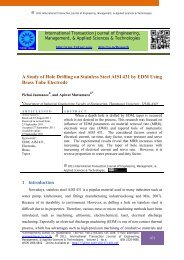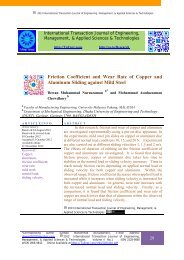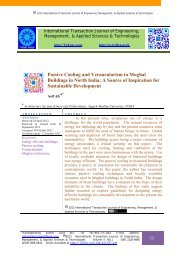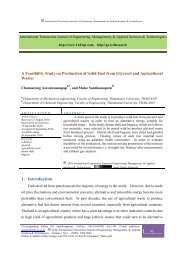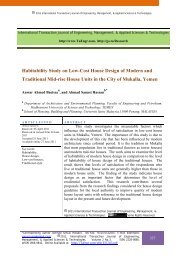Power Management in Mobile Adhoc Network - International ...
Power Management in Mobile Adhoc Network - International ...
Power Management in Mobile Adhoc Network - International ...
Create successful ePaper yourself
Turn your PDF publications into a flip-book with our unique Google optimized e-Paper software.
only when these are <strong>in</strong> use. There exist two energy efficient algorithms based on AODV as:<br />
AODVE and AODVM. In AODVE, to <strong>in</strong>crease the lifetime rout<strong>in</strong>g is based on the m<strong>in</strong>imum<br />
rema<strong>in</strong><strong>in</strong>g energy metric and that route is selected <strong>in</strong> which there is a maximum of m<strong>in</strong>imum<br />
rema<strong>in</strong><strong>in</strong>g energy (MIN_RE) and this field is added <strong>in</strong> RREQ as well as <strong>in</strong> the RREP. Other<br />
parameters are same as <strong>in</strong> AODV. Similar to AODVE, the latter AODVM considers the<br />
residual energy but it also considers the hop count value. It <strong>in</strong>creases the lifetime of a network<br />
by arrang<strong>in</strong>g almost all nodes to <strong>in</strong>volve <strong>in</strong> data transfer. It also shows improvement <strong>in</strong> delay<br />
and energy consumption of node. In new AODV protocol, the energy state of each node as<br />
well as of the entire network has been considered. New field is added to the RREQ message<br />
which carries the collected rema<strong>in</strong><strong>in</strong>g energy of nodes participat<strong>in</strong>g between source and the<br />
dest<strong>in</strong>ation. In this, dest<strong>in</strong>ation node does not give an immediate reply to the request but waits<br />
for some time and <strong>in</strong> the mean time, calculate the mean energy of the network and this is<br />
stored <strong>in</strong> each node. In case of a new route, this mean energy is then compared with the<br />
energy rema<strong>in</strong><strong>in</strong>g <strong>in</strong> the node and if it is less, then RREQ message is delayed by some time<br />
and by this the entire lifetime is extended. In energy aware AODV protocol, rout<strong>in</strong>g is done <strong>in</strong><br />
the similar way as <strong>in</strong> ADOV but l<strong>in</strong>k breakage is detected by Signal-to-Interference Ratio<br />
(SIR). Cross layer <strong>in</strong>teraction is also used by which physical layer can give <strong>in</strong>formation about<br />
l<strong>in</strong>k state to the network layer. Directional antennas are also used <strong>in</strong> energy aware AODV<br />
protocol to improve the communication Range and hence reduc<strong>in</strong>g <strong>in</strong>terference. In our<br />
proposed algorithm, the nodes are selected on the basis of their energy status, which help <strong>in</strong><br />
discover<strong>in</strong>g alternate paths. In proposed algorithm, neighbor<strong>in</strong>g nodes (backbone nodes) of<br />
active route hav<strong>in</strong>g energy above than some threshold value are selected for route<br />
establishment between source and dest<strong>in</strong>ation. Some modifications have been done to<br />
improve the performance of AODV. It controls the transmission power consumption of nodes<br />
by listen<strong>in</strong>g to only their messages. This is done by add<strong>in</strong>g two fields to RREQ and RREP<br />
packets. It also <strong>in</strong>creases the lifetime of a network by judg<strong>in</strong>g the duplicity of broadcast.<br />
3. Proposed Plan<br />
The objective is to provide an energy efficient, more stable and long last<strong>in</strong>g path from<br />
source to dest<strong>in</strong>ation. This has been done by modify<strong>in</strong>g AODV protocol. A new rout<strong>in</strong>g<br />
scheme has been designed for mobile adhoc network with large number of nodes. It can<br />
handle a variety of data traffic levels. This scheme is designed for network topology <strong>in</strong> which<br />
the nodes can trust each other and there are no malicious <strong>in</strong>truder nodes. The new rout<strong>in</strong>g<br />
218 Sunil Taneja, Ashwani Kush, Amandeep Makkar, and Bharat Bhushan


